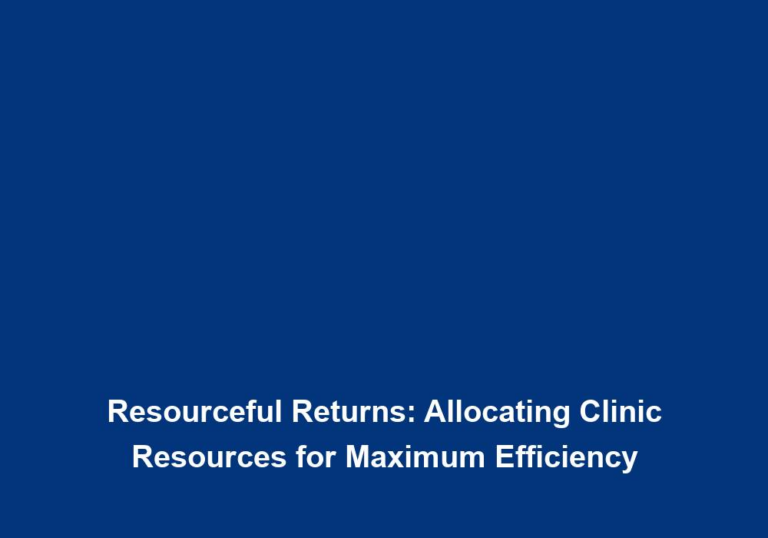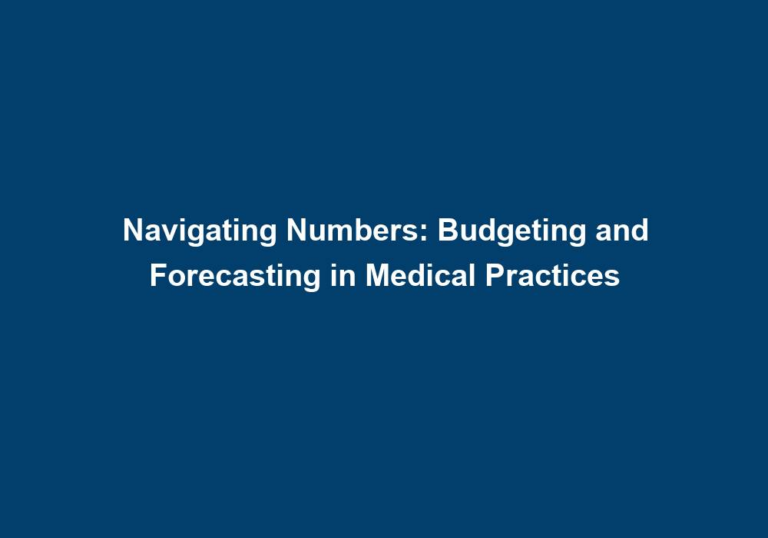Smart Spending: Efficient Resource Allocation in Healthcare Budgeting
In today’s rapidly evolving healthcare landscape, efficient resource allocation is crucial to ensure optimal utilization of funds and deliver high-quality care. With the constant pressure to control costs while improving patient outcomes, healthcare organizations must adopt smart spending strategies that maximize the value of their budget. This article explores various approaches and best practices for effective resource allocation in healthcare budgeting.
Understanding the Importance of Resource Allocation
Resource allocation refers to the process of distributing available resources, such as finances, personnel, and equipment, to different areas of healthcare operations. It involves making informed decisions based on needs, priorities, and projected outcomes. Efficient resource allocation is essential for several reasons:
- Optimizing Patient Care: Proper allocation of resources ensures that patients receive timely and effective care, leading to improved health outcomes. It helps healthcare organizations identify and address gaps in service delivery, reduce waiting times, and enhance patient satisfaction.
Efficient resource allocation allows healthcare organizations to identify areas where patients may be experiencing delays or gaps in service delivery. By allocating resources strategically, organizations can reduce waiting times, improve patient satisfaction, and ultimately enhance health outcomes. For example, by investing in additional staff or equipment in high-demand areas such as emergency departments, organizations can ensure that patients receive timely and effective care.
- Cost Containment: Effective resource allocation helps control healthcare costs by identifying areas of wasteful spending and reallocating resources to areas with higher value. By making data-driven decisions, organizations can minimize unnecessary expenses, reduce duplication, and streamline operations.
One of the key benefits of efficient resource allocation is cost containment. By analyzing financial data and operational metrics, healthcare organizations can identify areas of wasteful spending and reallocate resources to areas with higher value. For instance, by implementing lean management principles, organizations can minimize duplication of services, reduce unnecessary administrative costs, and streamline operations. This not only helps control healthcare costs but also ensures that resources are utilized in the most cost-effective manner.
- Maximizing Efficiency: Strategic resource allocation ensures that healthcare providers have the necessary tools, technologies, and personnel to deliver care efficiently. It helps minimize bottlenecks, improve workflow, and enhance overall productivity.
Efficient resource allocation plays a crucial role in maximizing efficiency within healthcare organizations. By ensuring that healthcare providers have access to the necessary tools, technologies, and personnel, organizations can minimize bottlenecks and optimize workflow. For example, by investing in electronic health records (EHR) systems, organizations can streamline documentation processes, reduce administrative burden, and improve communication among healthcare teams. This ultimately leads to enhanced productivity and improved patient care.
- Planning for the Future: By analyzing current and projected needs, healthcare organizations can allocate resources in a manner that supports long-term growth and sustainability. It allows them to adapt to changing demographics, advancements in technology, and emerging healthcare trends.
Efficient resource allocation involves not only addressing immediate needs but also planning for the future. By analyzing current and projected needs, healthcare organizations can allocate resources in a manner that supports long-term growth and sustainability. For instance, by investing in research and development, organizations can stay ahead of emerging healthcare trends and adopt new technologies that improve patient care. Additionally, by considering changing demographics, organizations can allocate resources to meet the specific needs of different patient populations, ensuring equitable access to quality healthcare services.
Best Practices for Efficient Resource Allocation
To achieve smart spending and efficient resource allocation in healthcare budgeting, organizations should consider the following best practices:
1. Conduct a Comprehensive Needs Assessment
Before allocating resources, it is crucial to conduct a thorough needs assessment. This involves evaluating the current state of healthcare services, identifying gaps or areas for improvement, and understanding the specific needs of the patient population. By gathering data and engaging stakeholders, organizations can make informed decisions about resource allocation.
A comprehensive needs assessment is the foundation for efficient resource allocation. By evaluating the current state of healthcare services, organizations can identify gaps or areas for improvement. This involves analyzing data on patient demographics, health outcomes, and utilization patterns. Additionally, engaging stakeholders such as healthcare professionals, patients, and community members allows organizations to gather valuable insights and perspectives. By combining data analysis and stakeholder input, organizations can make informed decisions about resource allocation that align with the needs of the patient population.
2. Prioritize Based on Impact and Value
Not all areas of healthcare require equal investment. It is essential to prioritize resource allocation based on the potential impact on patient outcomes and the value it brings to the organization. By focusing on interventions or initiatives that yield the highest return on investment, healthcare organizations can optimize resource utilization.
Prioritizing resource allocation based on impact and value is crucial for efficient budgeting. By identifying interventions or initiatives that have the potential to significantly improve patient outcomes, organizations can allocate resources where they will have the greatest impact. This involves considering the evidence base for different interventions, evaluating cost-effectiveness, and assessing the alignment with organizational goals. By prioritizing investments that yield the highest return on investment, organizations can optimize resource utilization and ensure that limited funds are allocated to areas that bring the most value.
3. Embrace Data-Driven Decision Making
Data analytics plays a vital role in smart spending and efficient resource allocation. Healthcare organizations should leverage data to identify patterns, trends, and opportunities for improvement. By analyzing clinical outcomes, financial data, and operational metrics, organizations gain insights that guide effective resource allocation decisions.
Data-driven decision making is essential for efficient resource allocation. By leveraging data analytics, healthcare organizations can identify patterns, trends, and opportunities for improvement. For example, by analyzing clinical outcomes, organizations can identify areas where additional resources may be needed to improve patient outcomes. Financial data analysis can help organizations identify areas of high cost or wasteful spending, allowing for reallocation of resources to more cost-effective areas. Operational metrics, such as patient flow and wait times, can provide insights into bottlenecks and inefficiencies that can be addressed through resource allocation. By embracing data-driven decision making, healthcare organizations can make informed choices that maximize the efficiency and effectiveness of resource allocation.
4. Collaborate and Engage Stakeholders
Engaging stakeholders, including healthcare professionals, administrators, patients, and community members, is crucial for successful resource allocation. Collaboration ensures that diverse perspectives are considered, and decisions align with organizational goals and community needs. By involving stakeholders in the process, organizations gain buy-in and foster a sense of ownership.
Collaboration and stakeholder engagement are key to successful resource allocation. By involving healthcare professionals, administrators, patients, and community members in the decision-making process, organizations can ensure that diverse perspectives are considered. This fosters a sense of ownership and buy-in from stakeholders, increasing the likelihood of successful implementation. Additionally, collaboration allows decisions to align with organizational goals and community needs, ensuring that resource allocation decisions are not made in isolation. By incorporating different perspectives and expertise, organizations can make more informed and effective resource allocation decisions.
5. Consider Long-Term Sustainability
While addressing immediate needs is essential, healthcare organizations must also consider long-term sustainability. This involves allocating resources to support preventive care, health promotion, and infrastructure development. By investing in primary care, chronic disease management, and health education, organizations can reduce future costs and improve population health.
Long-term sustainability should be a consideration in resource allocation decisions. While it is important to address immediate needs, organizations must also allocate resources to support preventive care, health promotion, and infrastructure development. By investing in primary care and chronic disease management, organizations can reduce the burden of preventable illnesses and associated costs. Health education initiatives can empower individuals to make informed decisions about their health, leading to improved population health outcomes. By considering long-term sustainability, healthcare organizations can allocate resources in a manner that not only addresses current needs but also sets the stage for future cost savings and improved population health.
6. Monitor and Evaluate Resource Allocation
Resource allocation is an ongoing process that requires continuous monitoring and evaluation. By tracking the impact of resource allocation decisions, organizations can identify areas for improvement and make necessary adjustments. Regular evaluation allows for course correction and ensures that resources are being utilized optimally.
Monitoring and evaluation of resource allocation decisions are essential for continuous improvement. By tracking the impact of resource allocation, organizations can identify areas that may require adjustments or reallocation of resources. This involves collecting data on key performance indicators, such as patient outcomes, cost savings, and efficiency measures. Regular evaluation allows organizations to identify areas of success and areas for improvement, enabling course correction and optimization of resource utilization. By continuously monitoring and evaluating resource allocation, organizations can ensure that funds are being utilized optimally and that the desired outcomes are being achieved.
Conclusion
Efficient resource allocation is a critical component of smart spending in healthcare budgeting. By conducting comprehensive needs assessments, prioritizing based on impact, embracing data-driven decision making, collaborating with stakeholders, considering long-term sustainability, and monitoring and evaluating resource allocation, healthcare organizations can optimize the utilization of funds while delivering high-quality care. Smart spending not only helps control costs but also improves patient outcomes, enhances efficiency, and sets the stage for future growth and innovation in healthcare.







